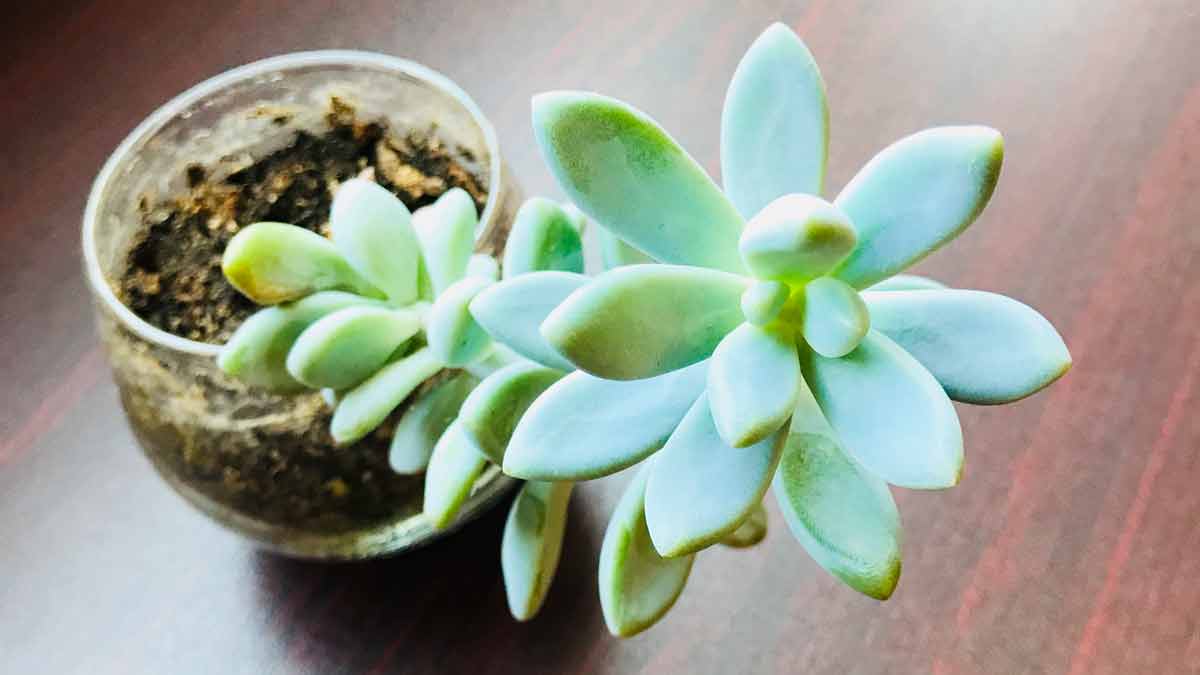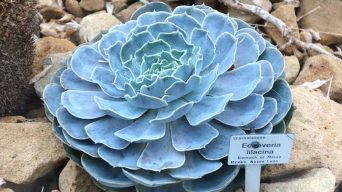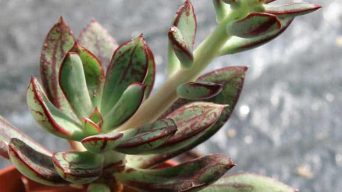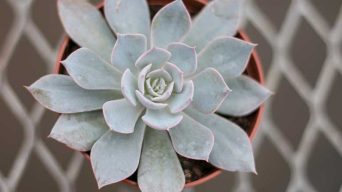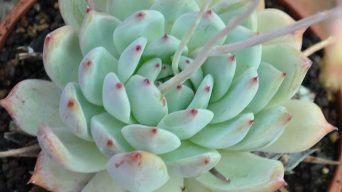Key Takeaways
- Leggy growth in Echeveria plants can be caused by insufficient light, over-fertilization, and temperature fluctuations.
- To treat a leggy Echeveria plant, trim and prune the stems, repot it for better support and fresh soil, adjust light levels to promote compact growth, and fertilize it appropriately with diluted fertilizer explicitly made for succulents.
- Prevent leggy Echeverias by providing optimal amounts of sunlight daily (at least six hours per day), watering correctly, ensuring adequate drainage, and managing soil moisture and nutrient levels accordingly.
Are you struggling with a leggy Echeveria plant that’s stretching out and losing its charming rosette shape? You’re not alone!
These popular, drought-tolerant succulents can often grow tall, spindly, and unattractive due to various factors.
Fortunately, our comprehensive guide is here to help you identify the causes of leggy growth in your Echeveria and provide practical solutions for treating it.
We’ll also discuss how to prevent this issue from happening in the first place so that your Echeveria remains healthy and vibrant.
Identifying A Leggy Echeveria
A leggy Echeveria is easy to spot, exhibiting a tall, stretched stem with widely spaced leaves rather than the plant’s natural compact rosette form.
The leaves on a leggy Echeveria succulent may become smaller and less plump over time due to their struggle for sunlight and insufficient photosynthesis.
To better understand what causes this phenomenon in your beloved houseplant, take note of its current growing conditions – how much light your Echeveria receives each day and whether it has been recently repotted or fertilized.
Observing these factors will help you determine if any changes are needed to restore balance and promote healthy growth in your Echeveria plant.
Causes Of Leggy Growth In Echeveria Plants
One of the leading causes of leggy growth in echeveria plants is insufficient light, causing a condition known as etiolation.
This occurs when your Echeveria, which originates from Central and South America, experiences inadequate levels of sunlight to support its photosynthesis process.
As a result, the plant stretches outwards for more light exposure, developing elongated stems with paler leaves that are less vibrant than healthy ones.
Another factor contributing to leggy echeverias includes improper fertilization techniques.
Over-fertilizing your plant can encourage rapid and unnatural growth spurts that may not align with typical compact succulent characteristics.
For instance, using a high-nitrogen fertilizer or applying an excessive amount can generate quick stem and leaf extension without allowing proper time for full root development.
Fluctuations in temperature also contribute significantly to leggy growth patterns for these hardy desert-adapted plants.
Consistently exposing your echeveria succulents to extremely cold or high temperatures during growing seasons might disrupt their regular biological processes essential for maintaining their signature plump appearance.
How To Treat A Leggy Echeveria Plant
You can encourage new growth by trimming and pruning its stems if you have a leggy Echeveria plant.
Repotting the Echeveria plant can also provide better support.
Adjusting the light levels can promote more compact growth while fertilizing it can contribute to healthy growth.
You can also propagate healthy Echeveria plants for new growth.
Trimming And Pruning To Promote Growth
Proper trimming and pruning are essential to treat a leggy Echeveria plant, promoting healthy growth and restoring its beautiful appearance.
Here are some tips for effective trimming and pruning:
- Use sharp scissors or pruners to ensure clean cuts and prevent damage to the plant.
- Cut off the top of the elongated succulent, leaving some stems for new growth.
- Remove dead or damaged leaves from the lower half of the succulent to encourage new growth.
- Make clean breaks when snapping off roots and healthy leaves from the bottom half of the plant, as this helps stimulate new growth.
- Dispose of removed plant material carefully to avoid spreading pests or diseases.
- Monitor your Echeveria after pruning, adjusting its care routine if necessary, such as moving it to a sunnier spot or adding a grow light for better growth.
- Allow trimmed stems time to callous before replanting them in a well-draining soil mix for successful propagation.
- Combine pruning with other strategies like adjusting light levels and proper watering techniques for optimal treatment of leggy Echeveria plants.
By following these guidelines, you’ll be on your way to improving your Echeveria’s overall health, resulting in more compact and attractive growth patterns that any plant owner will appreciate.
Repotting For Better Support
If your Echeveria plant has become leggy, repotting it can help provide better support and encourage healthier growth.
Follow these steps to ensure success:
- Choose a container that is only slightly larger than the current one. Too much space will lead to overwatering and potentially cause root rot.
- Use a well-draining potting mix specifically formulated for succulents, or make your own by combining soil, sand, and perlite in equal parts.
- Gently remove the plant from its current container, careful not to damage the roots.
- Remove dead or damaged roots and trim excessively long stems or leaves.
- Place a layer of fresh potting mix in the bottom of the new container and set the plant on top, ensuring it is level and centered.
- Fill around the plant with fresh potting mix, leaving about 1 inch of space at the top for watering.
- Water lightly to settle the soil around the roots, careful not to overwater.
- Allow the plant to adjust to its new environment for several days before resuming normal care.
Repotting can also be an opportunity to propagate healthy leaves or stem cuttings from your Echeveria plant and start new growth in separate containers.
With proper care and attention, your refreshed Echeveria will soon thrive with stronger structure and plump foliage.
Adjusting Light Levels To Encourage Compact Growth
One of the main reasons succulents become leggy is due to a lack of sunlight.
It’s important to adjust the light levels for your plant to encourage compact growth.
If you notice that your succulent is reaching out towards the window or growing lanky stems, it’s probably not getting enough direct sunlight.
If placing your succulent in direct sunlight isn’t an option, adding a grow light can be an effective solution.
A high-quality LED grow light placed directly above the plant can provide additional light without any risk of burning leaves.
Fertilizing For Healthy Growth
One of the most important factors in maintaining healthy Echeveria plants is fertilizing.
However, it’s essential to be cautious when fertilizing succulents, as over-fertilization can lead to leggy growth and root rot.
To ensure healthy growth in your Echeveria plant, use a fertilizer specifically made for succulents and cacti and dilute it to half-strength.
Another important tip is to avoid getting fertilizer on the leaves of your Echeveria plant, as this can cause burns that may damage its ability to photosynthesize.
When applying fertilizer, always water your plant first so that its roots absorb the nutrients correctly.
Propagating Healthy Plants For New Growth
Propagating healthy Echeveria plants is a great way to create new growth and expand your collection.
Here are some tips for propagating leggy Echeveria plants:
- Cut off the top of the leggy plant and allow it to dry for several days.
- Plant the cutting deeper than its original depth to encourage new root growth.
- Avoid watering the cutting until roots have formed, as excess moisture can cause rot.
- Place the cutting in bright light but avoid direct sunlight to prevent burning.
- Once roots have formed, gradually increase watering and move the new plant into a larger container with well-draining soil.
- Carefully monitor the new plant for signs of pests or disease, and adjust care as needed.
Remember to be patient when propagating succulents, as it can take several weeks or even months for new growth to appear.
But with proper care and attention, you can quickly expand your collection and enjoy healthy, vibrant plants year-round!
How To Prevent Leggy Echeveria Plants
To avoid leggy Echeveria plants, it’s crucial to provide them with the right amount of sunlight, water them correctly, maintain appropriate soil and nutrient levels, and refrain from over-fertilizing.
Optimal Sunlight For Healthy Growth
Echeveria plants need a lot of bright sunlight to grow healthy and maintain their compact shape.
Giving them at least six hours of direct sunlight daily is recommended, but make sure not to expose them to scorching rays during the hottest parts of the day.
If you’re growing Echeveria indoors, place them in a well-lit room with plenty of natural light, or use artificial lights if necessary.
A lack of adequate sunlight can cause Echeverias to stretch out unnaturally, resulting in weak stems and fewer leaves.
When succulents are deprived of sufficient light, they tend to elongate toward the nearest source, which leads to loose-compacted cells that cannot support plant structure properly.
Proper Watering Techniques
Watering Echeveria plants correctly prevent leggy growth and keeps them healthy.
Here are some proper watering techniques to keep in mind:
- Water from the bottom: Instead of watering your Echeveria plant from the top, pour water into the drainage tray beneath the pot. This allows the plant to absorb water gradually and prevents excess moisture from pooling around the roots.
- Use well-draining soil: Echeverias need soil that drains well to avoid root rot and other problems. Ensure your potting mix contains a high percentage of perlite or sand to increase drainage.
- Water sparingly: Overwatering is a common cause of leggy Echeveria plants. Only water when the soil is completely dry, usually every 10-14 days during the growing season and every three weeks during the winter.
- Avoid getting water on leaves: Getting water on Echeveria leaves can lead to fungal diseases. Try to direct all water toward the base of the plant.
- Don’t let the soil get too wet: Wet soil can cause root rot and other problems, especially if your pot lacks drainage holes. Check the bottom tray regularly for standing water and empty it if necessary.
Following these proper watering techniques can help your Echeveria plants thrive and avoid leggy growth.
Always check your plants’ needs, as different species may have slightly different watering requirements.
Soil And Nutrient Management To Support Growth
Proper soil and nutrient management prevent leggy growth in Echeveria plants.
These succulents require well-draining soil, as they are susceptible to root rot if their roots sit in stagnant water.
In terms of nutrients, these plants require an adequate amount of fertilizer throughout the growing season.
However, too much fertilizer can cause them to stretch out and become leggy.
It’s best to use a succulent fertilizer with a weaker dosage or dilute regular fertilizer by half before applying it to your Echeveria plant.
Avoiding Over-Fertilization
Over-fertilization is a common cause of leggy growth in Echeveria plants.
It’s important to remember that these plants are naturally drought-tolerant and don’t require as much fertilizer as other houseplants.
To avoid over-fertilizing your Echeveria plant, use the recommended amount of succulent-specific fertilizer during the growing season.
During winter months, when the plant goes dormant, reduce or stop fertilizing altogether because the plant does no nutrient absorption during dormancy.
Also, read the instructions on all soil amendment labels before applying them so you don’t apply higher than required rates out of confusion or haste.
Final Thoughts
A leggy Echeveria plant can indicate poor care and that it’s time to take action.
You can ensure your succulents remain healthy and vibrant by identifying the causes and knowing how to treat and prevent leggy growth.
With a few simple steps like repotting, pruning, adjusting light levels, or propagating new plants, you can fix any issues and enjoy your thriving Echeverias for years to come.

